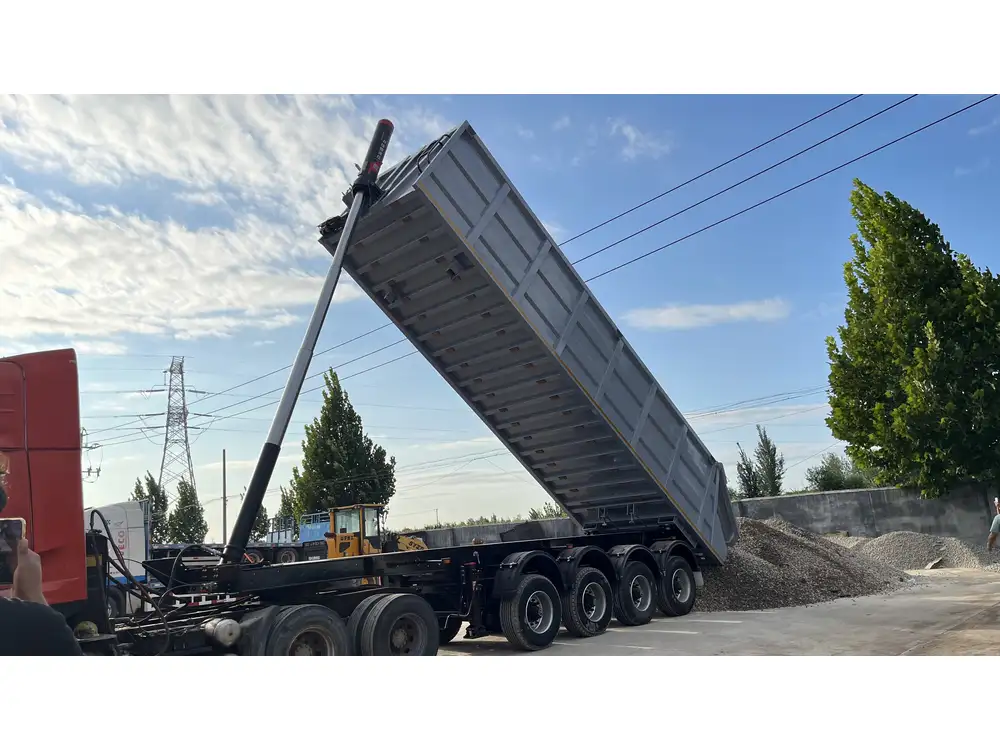Operating a side dump trailer effectively is crucial for efficiency and safety in the transportation industry. This versatile type of trailer is designed to facilitate the unloading of bulk materials with minimal manual handling. The following sections provide a detailed breakdown of the operation process while addressing common concerns and advanced techniques that ensure optimal performance.
Understanding the Side Dump Trailer
What is a Side Dump Trailer?
A side dump trailer is a specialized vehicle that allows for the discharge of materials from the side, rather than the traditional rear. This is particularly useful in construction, mining, and agricultural applications. The operational mechanism involves hydraulic systems that enable the trailer’s bed to tilt and release materials on either side.

Major Components of a Side Dump Trailer
- Trailer Frame: The structural foundation that supports the trailer.
- Dump Bed: The section of the trailer that holds the payload.
- Hydraulic System: The mechanism that controls the tilting of the bed.
- Axles and Wheels: Components that provide mobility and support the weight of the trailer.
- Kingpin and Coupling Mechanism: Connects the trailer to the towing vehicle.
- Safety Features: Includes locks and alarms to ensure safe operation.
Preparation Before Operation
1. Inspect Your Equipment
Before operating a side dump trailer, it is imperative to conduct a comprehensive inspection. Here’s a checklist:
- Hydraulic System: Ensure that there are no leaks and that all hoses are securely attached.
- Brake System: Check for proper function and wear.
- Tires: Inspect for adequate tread and correct inflation.
- Lighting: Ensure that all lights are operational for safety.

2. Review Operating Procedures
Familiarize yourself with the manufacturer’s manual and understand the specific operating procedures. Each trailer might have unique controls or specifications.
3. Train on Safety Protocols
Safety should be your top priority. Ensure that you and your team understand:
- Proper loading practices
- The importance of proper weight distribution
- Safety protocols for working near the trailer
Step-by-Step Operating Process

Step 1: Connecting the Side Dump Trailer
Proper hitching is vital for safety and operational efficiency. Follow these steps for a secure connection:
- Align the trailer tongue with the towing vehicle’s hitch.
- Insert the kingpin and engage the locking mechanism.
- Conduct a safety check by pulling the trailer slightly to ensure it is securely hitched.
Step 2: Loading the Trailer
Proper loading techniques enhance stability and safety:
- Distribute Weight Evenly: Ensure that the load is balanced across the trailer to prevent tipping.
- Avoid Overloading: Understand the trailer’s weight capacity; exceeding this can lead to operational failure and safety hazards.
- Use Proper Equipment: Depending on the material, use loaders that match the task.
Step 3: Preparing to Dump
When it’s time to unload, ensure the area is clear of obstacles:
- Positioning: Park the trailer on level ground to ensure a smooth dump process.
- Safety Zone: Establish a safe working perimeter to keep personnel clear.

Step 4: Dumping Material
Follow these steps for a safe unloading process:
- Engage the Hydraulic System: Activate the control mechanism cautiously.
- Tilt the Bed: Allow the trailer bed to tilt slowly. Monitor for stability.
- Unload Material: The material will slide out. Continue to check surroundings for safety.
- Return to Upright Position: Once empty, return the bed to its original position before moving.
Step 5: Disconnecting the Trailer
After unloading, ensure that all procedures are followed when disconnecting:
- Engage the Brake: Always set the parking brake prior to disconnection.
- Detach the Tow: Once secured, release the coupling mechanism from the towing vehicle.
- Perform Final Checks: After disconnection, inspect the trailer once more for cleanliness and functionality.
Troubleshooting Common Issues
Here are some common operational issues with side dump trailers, along with solutions:
| Issue | Symptoms | Solutions |
|---|---|---|
| Hydraulic Failure | Bed won’t tilt | Check fluid levels and hose connections for leaks. |
| Overloaded Trailer | Poor handling, difficulty in braking | Reassess load distribution; reduce weight if necessary. |
| Tire Issues | Vibration during transport | Inspect tires for damage; ensure proper inflation. |
| Unstable Dumping | Trailer tips over during unloading | Ensure a level unload area; avoid overloading. |

Advanced Operations Tips
Maximizing Efficiency:
Speed Control: Invest time in learning how to control the speed of your hydraulic system. Rapid movements can lead to spills and accidents.
Material Awareness: Different materials may require different unloading techniques. Fine-tune your approach based on what you’re transporting.
Environmental Considerations: Be aware of your surroundings. Uneven terrains or strong winds can affect the stability of your side dump operation.
Regular Maintenance: Follow a strict maintenance schedule to keep all components in optimal condition. Hydraulic fluid, brakes, and tires should be checked regularly to avoid unexpected failures.
Utilizing Technology: Consider modern options that incorporate tech advancements such as onboard scales for accurate weight measurements and GPS for route optimization.
Best Practices for Safety
- Proper Training: Ensure that all operators are well-trained and certified when necessary.
- Use Personal Protective Equipment (PPE): Always wear appropriate gear such as gloves, helmets, and high-visibility clothing.
- Emergency Plans: Have clear emergency procedures in place. Operators should know how to react in the case of hydraulic failure or load spillage.
Conclusion
Understanding how to operate a side dump trailer is not merely about knowing the control mechanisms; it encompasses a thorough approach to safety, maintenance, and strategic loading and unloading techniques. By following the detailed steps outlined in this guide and focusing on best practices, operators can significantly enhance their efficiency while ensuring the utmost safety for themselves and their teams. The mastery over these machines not only leads to smoother operations but also saves time and minimizes costs associated with potential accidents and equipment damage. Embrace the knowledge shared here and navigate the world of side dump trailers like a seasoned professional.



